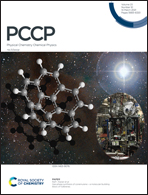Synergistic vacancy defects and mechanical strain for the modulation of the mechanical, electronic and optical properties of monolayer tungsten disulfide†
Abstract
Monolayer transition metal dichalcogenides (TMDs) are the potential candidate materials in nanoelectronic and optoelectronic applications due to their unique physical and chemical properties. Although both defect and strain greatly alter the structural, physical and chemical properties of monolayer TMDs, the defective monolayer TMDs under applied strain have not been adequately studied. In this paper, the synergistic effects of sulfur vacancy defects and mechanical strain on the mechanical, electronic and optical properties of monolayer tungsten disulfide (WS2) have been systematically studied using first principles density functional theory. The results indicate that the sulfur vacancy formation energy increases linearly with increasing sulfur vacancy concentration under different strains. The strain energy and stress of monolayer WS2 with different sulfur vacancy concentrations increase with increasing applied strain in the strain range of −10% to 10%. The band gap of monolayer WS2 decreases with increasing sulfur vacancy concentration under different strains. Moreover, compared with unstrained conditions, 5% compressive strain increases the band gap at a larger vacancy concentration and the case is just opposite at a smaller vacancy concentration, while 5% tensile strain decreases the band gap. The band gap of monolayer WS2 with different sulfur vacancy concentrations firstly increases and then shrinks with increasing applied strain under compressive strain, whereas it decreases monotonically under tensile strain in the strain range of −10% to 10%. In the visible-light wavelength region, the out-of-plane absorption coefficient under different strains increases with increasing sulfur vacancy concentration. Furthermore, 5% compressive strain enhances the absorption coefficient and 5% tensile strain decreases the absorption coefficient. Hence, the synergistic effects of sulfur vacancy defects and mechanical strain in monolayer TMDs can open new avenues for their applications in nanoelectronic and optoelectronic devices.



 Please wait while we load your content...
Please wait while we load your content...